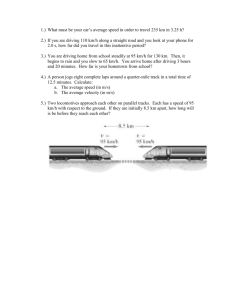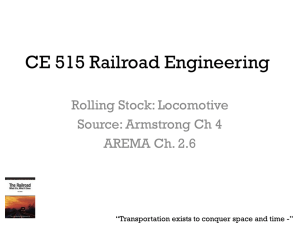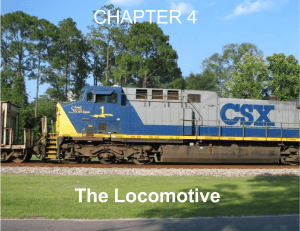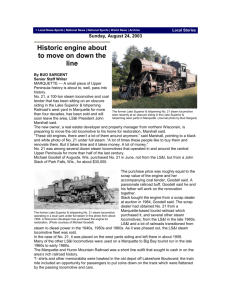BLET-CSXT LOCOMOTIVE CAB COMMITTEE
advertisement
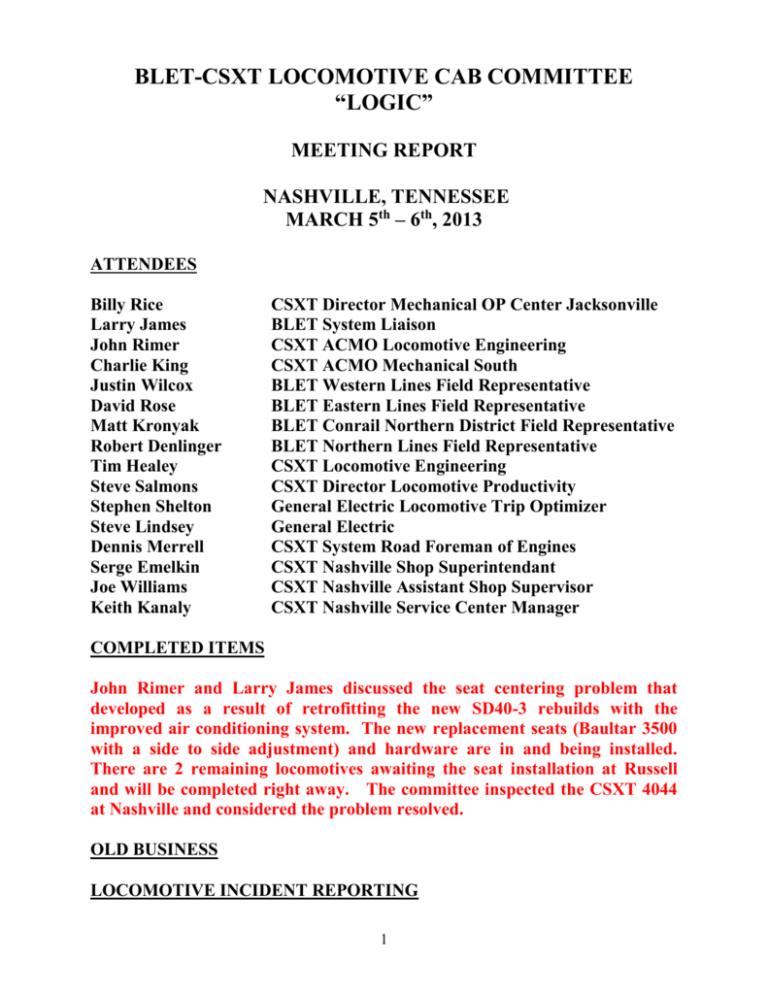
BLET-CSXT LOCOMOTIVE CAB COMMITTEE “LOGIC” MEETING REPORT NASHVILLE, TENNESSEE MARCH 5th – 6th, 2013 ATTENDEES Billy Rice Larry James John Rimer Charlie King Justin Wilcox David Rose Matt Kronyak Robert Denlinger Tim Healey Steve Salmons Stephen Shelton Steve Lindsey Dennis Merrell Serge Emelkin Joe Williams Keith Kanaly CSXT Director Mechanical OP Center Jacksonville BLET System Liaison CSXT ACMO Locomotive Engineering CSXT ACMO Mechanical South BLET Western Lines Field Representative BLET Eastern Lines Field Representative BLET Conrail Northern District Field Representative BLET Northern Lines Field Representative CSXT Locomotive Engineering CSXT Director Locomotive Productivity General Electric Locomotive Trip Optimizer General Electric CSXT System Road Foreman of Engines CSXT Nashville Shop Superintendant CSXT Nashville Assistant Shop Supervisor CSXT Nashville Service Center Manager COMPLETED ITEMS John Rimer and Larry James discussed the seat centering problem that developed as a result of retrofitting the new SD40-3 rebuilds with the improved air conditioning system. The new replacement seats (Baultar 3500 with a side to side adjustment) and hardware are in and being installed. There are 2 remaining locomotives awaiting the seat installation at Russell and will be completed right away. The committee inspected the CSXT 4044 at Nashville and considered the problem resolved. OLD BUSINESS LOCOMOTIVE INCIDENT REPORTING 1 Billy Rice provided the committee with a handout showing a breakdown of reported locomotive cab incidents by type generated August 1, 2012 through February 1, 2013. Speed indicator and toilet issues continue to be the leaders in cab incident reporting. CSXT Mechanical representatives announced a Process Excellence Team is kicking off a speed indicator project. The Mechanical Desk is receiving numerous calls regarding speed indicators being off 1-2 mph. This is placing this item as the #2 in overall incident reporting. The FRA Guidelines up to 30mph are plus-minus 3 mph and over 30 mph plus-minus 5 mph. Mechanical indicated speed indicators that are off 1-2 mph are sometimes difficult to be calibrated to be exact. The rule of thumb is 1 MPH. Engineers are requested to report all speed indicators inaccurate 3mph or more to the Mechanical Desk and Train Dispatcher. Those off 1-2 mph should be noted on the Engineer Work Report. SEAT ISSUES The committee reviewed and discussed seat cushion defect reports received since the Jacksonville Meeting. Data indicates during the month of October 2012 16 flat seat cushions were reported and replaced. In November there were 12, December 18, January 29 and February 15. The total seat defect reports received in December and January were 57. The CSXT policy is flat or defective cushions will be changed when reported. Seats with NDF notations will be re-set in the system to have the cushions addressed again. The new seat inspection SMR covers all of the various seat issues the committee has addressed. Local Cab Committee Representatives, employees and System Committee Members continue to observe numerous defective Jaggers seats during observations at the service centers and while operating trains. These seats have stops knocked out, broken or removed from the seat back, are wobbly and have flat seat cushions. John Rimer indicated there is a remaining stock of new Jaggers seats that can be installed to replace defective seats until they are given a Baultar modification. Additionally, engineering is working on development of a tamper proof cover to prevent any tampering. If the seat back is defective and the gears are not properly working or allowing the back to drop incrementally on its own the seat needs to be reported immediately. The locomotive will be routed trail only to the shop with all CSD reports. 2 Additionally, John Rimer conveyed when Jaggers seats are found with the stops knocked out to report them and: Mechanical will address repairing or replacing the seat When seats are reported they will be OOS trail to shop for repair If the seat lays flat, it needs replaced. 108 seat defects were reported between August 2012 and February 2013. Committee members and employees are encountering numerous Jaggers pedestal mounted seats that are extremely wobbly. Several of these were noted during the inspection of locomotives at Nashville by the committee and GE. In 2012, 241 sets of new Baultar seats were installed replacing Jaggers. There have been 28 sets installed since the Jacksonville Meeting. The projections for 2013 include defective seat replacements, (GE repair of defective walls and cabs) 75 cab enhancements, and rebuilds will be equipped with new Baultar seats. New locomotives are being received with the Baultar center fold up cab seat. This will provide much needed additional room in the locomotive cab. The committee discussed a seat that was installed extremely high on the CSXT 7312. John Rimer indicated it was being sent to the shops for immediate correction. Justin Wilcox also noted finding both a Jaggers and Baultar seat mounted on the same side hardware. This was another improper installation. Justin Wilcox stated employees are hitting their knees on the light switches on newer EVO locomotives due to the closeness of the seat and control stand. He suggested installation of a smooth rounded plastic cover over these switches to prevent hitting ones knees. TOILET ISSUES 30 locomotives remain for installation of the electric exhaust fan wiring with 870 locomotives now complete. This item will be placed in monitoring status. 1728 locomotives now have been modified with the relocation of the toilet vent hoses and collection boxes to the rear of the locomotive ahead the fuel tank. This leaves 796 remaining and 51 complete since the last meeting. 3 287 Microphor Toilets remain in service. They are to be changed out upon reported defect. Numerous MEI toilets have been installed in which the vent hose is only attached to the inner restroom wall, have been found dangling on top of the truck and other improper installations. Additionally, the donut rings are deteriorating. CSXT provided proper installation procedures to GE and they are correcting all that have been reported. A new PVC adapter pipe has been developed by GE to correct the void between the walls issue associated with the failing donut ring. All new locomotives are coming with the new PVC pipe already installed at the factory The pipe will be available in the parts inventory on March 15 th. When locomotives are not properly vented it creates a condition where the toilet fumes are drawn into the operating cab. The toilet is clean and serviced but the cab has strong odors. Again, during the Nashville field trip locomotives were found with this defect and pointed out to GE representatives. GE has a new inspection program to verify the modification is done correctly and will now inspect all MEI toilet retrofits with special emphasis on reported locomotives. . The committee discussed reporting processes and remedies for locomotives found with standing water on the floor from leaking ice boxes. If ice box drains are stopped up, crews need to report this defect to the Mechanical Desk right away. Locomotives will be addressed promptly on report by being flagged and routed to the shop in trail. Steve Lindsey reported GE is inspecting the AC4400 fleet to insure the drain is functioning properly and changing to the new larger drain if the ice box is not equipped. The key to getting this problem resolved is to make certain everything is written up on the engineer work report and called in to Mechanical. Locomotives continue to be found with water cooler lines draining into the toilet floor area creating a safety hazard. Larry James indicated seeing several in the 200 series and lower numbers during field inspections. Reports continue to come in from the field regarding this issue. Steve Lindsey indicated GE has commenced an inspection program going through the fleet to correct. The program is starting with 590 locomotives of which 14% are complete. Several of these have been noted during System Locomotive Cab Committee field trips. UNINSTALLED ELECTRIC WINDOW DEFROSTERS Steve Lindsey of GE advised the materials are finally on order and the first installation will be done in April with the target goal of completion before winter. 4 CAB AIR CONDITIONING – HIGH PRIORITY The committee discussed the 2012 Air Conditioner Retro Fit Installation Program completions. In 2012, 125 locomotives were planned and the actual number of installations was 147. The plan for 2013 is a minimum of 125 plus the new order of locomotives arriving. This is well ahead of projections. Year to date 29 have been completed. During initial installations the new roof mounted cab air conditioners had two circuit breakers. A recent modification involving installation of new inverters the two circuit breakers were reduced to one. When both air conditioning units are turned on now the one breaker can’t handle the load and trips. John Rimer indicated Mechanical is aware of the issue. The locomotives need a higher capacity circuit breaker. A modification is coming right away to correct this issue. OSCILLATING FANS - HIGH PRIORITY 2 new fan sets have been installed year to date and will continue to equip the entire fleet. Special installation requests can be made on captive locomotives. 160 locomotives have active assigned modifications for installation. ADDITIONAL ITEMS FOR DISCUSION Currently 180 sets of the highly visible inner cab stairway covers from Power Rail Distribution have been installed. This includes 81 SD70’s, leaving 123 open. 99 other locomotives have received the installation. The SD70 models are the committee’s highest priority since they do not have inner stair railings. John Rimer will try to advance these installations. GE is working on a development kit for AC 4400 GE locomotives. CSXT Mechanical and GE are developing a cleaning process to keep the stairs highly visible. If they are not kept clean it diminishes their visibility capabilities that enhance cab safety. Cleaning of inner cab duct work and vents are completed during the 184 day quarterly inspections by GE. GE indicated new instructions are out to remove and clean the screens. GE is making certain shop personnel are checking these during maintenance. The modification is published for installation of a second brake stick holder on the engineer’s side of locomotives and has commenced. 18 5 locomotives are complete with 951 to do. All locomotives at Hamlet are complete. Larry James provided a review of recent Cumberland, Avon, Russell, Erwin and Nashville Local Cab Committee findings. John Rimer provided an update regarding the standardization of circuit breaker covers on the rear electrical panel inside the locomotive cab. There are currently several breakers that are covered that an employee has to operate during a proper shutdown procedure. In some cases there are 4-5 consecutive in which it is extremely difficult to get your fingers in to trip. The breaker covers and procedures should be in line with the information contained in the Engineer Manual. Action Item: Larry James will meet with Brandon Locklear of CSXT Mechanical Engineering and GE representatives at Russell in March to identify by model those circuit breakers needing a cover and what types of covers to recommend. Several issues and concerns including some safety related with Trip Optimizer were discussed with documentation provided. Steve Salmons of CSXT and Stephen Shelton of GE discussed concerns raised by the committee. David Rose provided several concerns in the Greenwood, Spartanburg and Cayce areas. Problems with data trip initialization have been caused by defective antennas that are now being replaced. GE is field testing new locomotive Trip Optimizer software to eliminate lockups. CSXT and GE need exact mileposts in areas where crews report severe run ins and run outs of slack or other issues have occurred. (Steve Salmons indicated some of these may be the result of the older version of hardware) When a crew logs their information into Trip Optimizer, if the screen depicts the auto dynamic brake is active and the independent control is active, then it has the new version of software. 853 out of 1070 are complete. During trip initialization, if the locomotive has a defective or early version of antenna, the cell modem will not activate and the system reverts back to satellite. This is what is causing long periods of time in initializing that crews are reporting. If the trip initialization doesn’t work on two attempts, crew should depart unless instructed otherwise. Crews must keep in mind ERAD will report the attempts made. Crews utilizing DP power must make certain to re-arrange their consist to show the DP locomotive on the rear and not the head end as it will 6 cause T.O. to program all locomotives as head end power that can create train handling or speed issues. ADDITIONAL UPDATES 789 locomotives have had the Software Modification installed to eliminate the troublesome alarm bell issues. 80% of the fleet is complete. 157 have been done since the Jacksonville Meeting and 228 locomotives remain. John Rimer provided an update regarding installation of a secure OBWO holder complete with a charging plug-in located inside the locomotive cab. Four have been installed for testing purposed and Mechanical is awaiting senior management’s decision to proceed. Procedures regarding the new Dash 8 horn guard covers are awaiting procedure development. GE has identified 319 locomotives to complete. The committee requested this item be prioritized. NEW BUSINESS The committee re-visited window cleaning issues at various locations. Charlie King will re-emphasize with the service centers. (During the Nashville field trip locomotives windows were clean) Recent reports and field trip inspections including Nashville have noted more disconnected wiper arms and some completely removed. GE reports that 37 new steel arms have been installed with 680 remaining. CSXT will commence a rebuild program for 4 axle locomotives in late 2013 such as the SD40-3. There are two prototypes currently at the Huntington Shop a GP40 and a GP 38. The emergency egress lights in the SD40-3 locomotives that have been noted with the bulbs missing are being replaced. This was noted on the CSXT 4044 in Nashville. The committee re-visited the GE super clean process with some photos of very dirty cab conditions. GE has had a meeting with their shop managers to reinforce proper procedures for the super clean process. Larry James stated several large leaks have been noted in locomotive roofs after PTC antenna installation. John Rimer indicated it was an installation issue as the spot weld was defective. These are all being corrected immediately. If a crew encounters one of these locomotives, they are to report it to the Mechanical Desk. Committee members inspected the CSXT 8700, 8704, 4044, 8723, 8369, 460, 269 and 5116 during the Nashville Service Center field trip. 7 The next meeting will be held on June 11th and 12th, at the Locomotive Shop in Cumberland, Maryland. Larry James Locomotive Cab Committee 8
